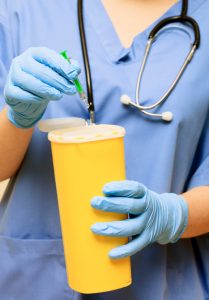Sports and Medical Waste
Medical waste on the sidelines? Ringside? Here’s how sports pros should deal with it.
What do medical technicians, doctors, and cutmen have in common? They all care for their patients, except these patients aren’t on the exam table. In sports like football, hockey, and especially boxing or mixed martial arts, these providers are out on the field, on the ice, and at ringside, ready to treat injuries as they happen. This means there will be medical waste.
Boxing and mixed martial arts are guaranteed to have medical waste. When a sport relies on physical contact in the form of fighting, there is blood, lacerations, broken bones, and plenty of bruises. Cutmen, the ones on the sidelines treating the athletes, have to be prepared to not only treat open wounds, but to dispose of the waste after they have handled blood and other bodily fluids.
Cutmen have 60 seconds between rounds to repair damage a boxer absorbs. They’re also responsible for controlling swelling and bleeding, relying on coagulants if necessary. This means cotton swabs, ointment, PPE, like disposable gloves, which generates quite a bit of medical waste.
In sports like hockey, there’s risk of cuts and lacerations due to fighting on the ice, collisions, and of course puck injuries. There’s even the risk of blade injuries from the skates themselves.
How do these professionals deal with the medical waste generated on the ice or in the ring? Common sense tells us that blood waste is particularly risky under bloodborne pathogen standards, and therefore is dealt with like any other medical waste
How should cutmen and other sports medicine professionals handle medical waste? With a few simple supplies, it’s rather easy.
Keep Red Bags On Hand
Red bag waste has had contact with a potential infectious agent and must be disposed of in a red biohazard waste bag. This includes:
- blood soaked items
- gauze
- bandages
- items containing dried blood or other fluids
- gloves
- personal protective equipment (PPE)
Red bags are impervious to moisture, strong enough to prevent tearing or bursting, and can be sealed before transporting, which is a must for medical waste.
Use Personal Protective Equipment (PPE)
Gloves, goggles, and other garments and equipment are designed to protect the wearer’s body from injury or infection. This is especially important for medical professionals treating out in the field where there is no room to go to wash up.
Generally, a waste management company that specializes in regulated medical waste, such as Red Bags will take sports medical waste off site and destroy the potential for harm from it. Because this waste has been contaminated by potentially infectious materials, it needs to be destroyed before it can be disposed of.
Medical waste is found in the least likely places, whether it’s ringside or on the sidelines, not just in hospitals and doctors’ offices.
Where there’s medical waste, there’s Red Bags to treat it and dispose of it safely and properly.
How does your facility protect staff from medical waste risks?
Related Articles:
- Avoid Medical Waste Risks in the Workplace
- Handling Medical Waste Containers
- Choosing the Right Sharps Containers for Your Facility
- What Is a Spill Kit? Who Needs Them?

Service Areas: Long Island Medical Waste; New York City Medical Waste; Westchester Medical Waste and more!
